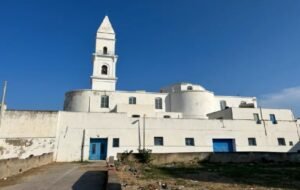24-11-2025
TUNIS: Night had just about fallen in Halq al-Wadi, also known as La Goulette, a balmy coastal suburb of Tunis, when the Virgin Mary emerged from the local church, Saint-Augustin and Saint Fidele, into a packed square.
 Carried on the shoulders of a dozen churchgoers, the statue of the Virgin was greeted with cheers, ululations and a passionately waved Tunisian flag.
Carried on the shoulders of a dozen churchgoers, the statue of the Virgin was greeted with cheers, ululations and a passionately waved Tunisian flag.
Hundreds of people, Tunisians, Europeans, and sub-Saharan Africans had gathered for the annual procession of Our Lady of Trapani.
Many of those participating in the procession, and the Catholic Mass that came beforehand, were from sub-Saharan Africa.
“It’s the Holy Virgin who has brought us all here today,” Isaac Lusafu, originally from the Democratic Republic of the Congo, told media. “Today the Virgin Mary has united us all”.
In a large, packed square just beyond the church gates, the statue moved in a circle as people prayed and sang hymns. It was all under the watchful eye of a mural of Claudia Cardinale, the renowned Italian actress born in La Goulette, a reminder of the distant past when the district was home to thousands of Europeans.
A melting pot
The Catholic feast of Our Lady of Trapani was brought to La Goulette in the late 1800s by Sicilian immigrants, in the days when the port town was a hub for poor southern European fishermen in search of a better life.
Immigration to Tunisia from Sicily peaked in the early 20th century. Nearly all of the fishermen, along with their families and descendants, have now returned to European shores, but the statue of the Virgin remained and, every year on August 15, it is carried in procession out of the church.
 “It’s a unique event,” Hatem Bourial, a Tunisian journalist and radio presenter, told media.
“It’s a unique event,” Hatem Bourial, a Tunisian journalist and radio presenter, told media.
He went on to describe how, in the procession’s heyday in the early 20th century, native Tunisians, Muslims and Jews alike, would join Tunisian-Sicilian Catholics in carrying the statue of the Virgin Mary from the church down to the sea.
There, participants would ask Mary to bless the fishermen’s boats. Many residents would shout “Long live the Virgin of Trapani! Bourial said, while others threw their chechia, a traditional red cap worn in the Maghreb, in the air.
As well as its religious significance for Catholics, August 15 marks the day that Mary was taken up into heaven, the feast also coincides with the Italian mid-August holiday of Ferragosto, which traditionally signals the high point of the summer.
Silvia Finzi, born in Tunis in the 1950s to Italian parents, described how, after the statue had been brought down to the sea, many of La Goulette’s residents would declare that the worst of the punishingly hot Tunisian summer was over.
“Once the Virgin had been taken down to the water, it was as if the sea had changed”, Finzi, a professor of Italian at the University of Tunis, told Al Jazeera.
“People would say ‘the sea has changed, the summer’s over’, and you wouldn’t need to go swimming to cool down any more”.
European exodus
The first European immigrants began to arrive in La Goulette in the early 19th century. Their numbers rapidly increased after 1881, when Tunisia became a French protectorate. At its height in the early 1900s, the number of Italian immigrants who were largely Sicilians across the whole of Tunisia is estimated to have been more than 100,000.
In the decade after 1956, when Tunisia gained its independence from France, the vast majority of its European residents left the country, as the new government pivoted towards nationalism. (Int’l News Desk)
 Pressmediaofindia
Pressmediaofindia




